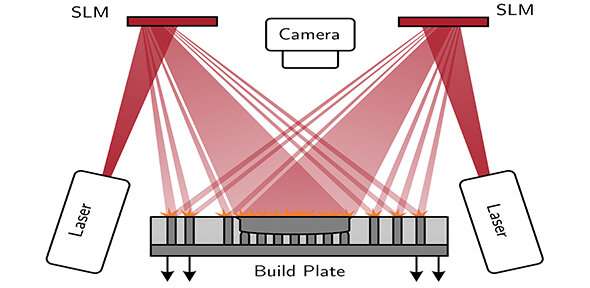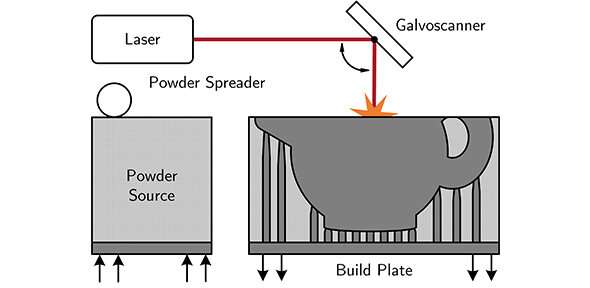Holographic beam shaping to deliver a boost to metallic 3-D printing

Cambridge engineers have begun a three-year research program to help speed up the manufacture of metallic 3-D printed parts and products, by using computer-generated holography.
In recent years, the manufacturing industry has witnessed a rise in the use of 3-D printing for sustainable solutions and customized products, producing high quality items at low cost. This has led to highly adventurous manufacturing techniques being developed, such as additive manufacture (AM), which has expanded the range of materials that can be processed, from plastics to metals and other more exotic materials.
Now, thanks to funding from the Engineering and Physical Sciences Research Council, Professor Tim Wilkinson and his team aim to strengthen metallic 3-D printing by using computer-generated holography to improve not only the quality of finished parts and products, but also to allow greater control over the metallic powder during the AM process.
State-of-the-art machines use a small laser spot to melt the powder, giving off intense heat, before gradually adding a thin layer upon layer of the material in order to make up a final manufactured part or product. But controlling this thermal energy is difficult due to the localized nature of the laser spot, leading to unpredictable stresses and distortions in the part being made. However, computer-generated holograms can help bring the distribution of this energy under control in three dimensions rather than two, as a result of optical diffraction (the bending of light waves around an obstacle). The melt process can then be monitored in real time and the hologram can be recalculated in order to control the shape, quality and material of the AM process.

The research team has begun working with plastic and resin AM in order to develop the algorithms needed to control the hologram. They will move onto using metal powder next.
Peter Christoper, Ph.D. student in Ultra Precision Engineering, said the aim is to melt an entire layer of metal powder simultaneously, thereby improving the speed of manufacture, as well as removing many of the thermal-related issues experienced in current approaches.
"3-D printing is becoming ever more popular today, both for hobbyists and for commercial projects," he said. "During the COVID-19 pandemic for example, we have seen thousands of scientists, engineers, researchers and medical professionals, 3-D printing parts for ventilators in mere hours, whereas traditional approaches would have taken months or years to set up. Metallic 3-D printing or additive manufacture (AM) has been slower to catch on, in part due to high expense, difficulty of use and technical challenges. Nowadays though, it is beginning to find use in small batches of complex parts. It is widely used in the medical industry for example, in producing customized implants.As a result of our holographic technique, we can use multiple light beams at the same time in order to build up a structure in a more three-dimensional way, and we can control the direction in which the light is traveling. This allows us greater control over any imperfections. We also hope that a new generation of liquid crystal displays will be produced as a result of this research, designed specifically for high power laser illumination in AM processes."
Provided by University of Cambridge





















